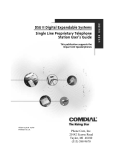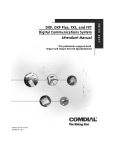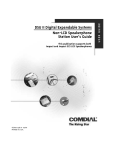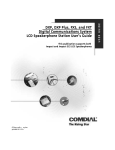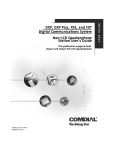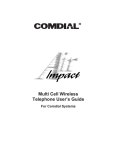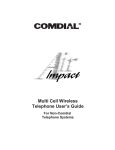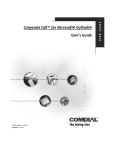Download Comdial Impact Attendant for Windows User Guide
Transcript
Impact Attendant for Windows Impact Attendant for Windows PC Attendant Console User’s Guide For The DXP, DXP Plus and FX Series Digital Communications Systems Comdial strives to design the features in our communications systems to be fully interactive with one another. However, this is not always possible, as the combinations of accessories and features are too varied and extensive to insure total feature compatibility. Accordingly, some features identified in this publication will not operate if some other feature is activated. Comdial disclaims all liability relating to feature non-compatibility or associated in any way with problems which may be encountered by incompatible features. Notwithstanding anything contained in this publication to the contrary, Comdial makes no representation herein as to the compatibility of features. Impact Attendant For Windows, User's Guide GCA70–355 Contents 1 Introducing Impact Attendant . . . . . . . . . . . . . . . . . . . . 1-1 Using This Guide........................................................................................................1-1 Describing Impact Attendant......................................................................................1-1 Starting The Program..................................................................................................1-2 Understanding Some Special Terms...........................................................................1-3 Detailing the Impact Attendant View.........................................................................1-4 Locating The Task Menus ................................................................................................1-4 Locating The Tool Bar .................................................................................................... 1-4 Describing The Station Status Icons.................................................................................1-5 Explaining The Selection Tabs........................................................................................ 1-5 Detailing The Call Display Windows...............................................................................1-6 Current Calls Display Window ..................................................................................1-6 Active Call Display Window .....................................................................................1-7 Stations and Lines Display Window..........................................................................1-7 Status Display Window..............................................................................................1-7 Setting The System Configurations............................................................................1-8 Attendant’s Telephone Number........................................................................................1-8 Pop to Top on Incoming Call ...........................................................................................1-8 Pop Group for Answered Call ..........................................................................................1-8 Hide When Done With Call..............................................................................................1-8 Beep When Popping Up ...................................................................................................1-8 Audit Log..........................................................................................................................1-9 Debug Mode .....................................................................................................................1-9 Using The Attendant’s Keyboard Interface................................................................1-9 Using The Attendant’s Computer Mouse Interface....................................................1-9 Contents - iii GCA70–355 2 Impact Attendant For Windows, User's Guide Using Impact Attendant . . . . . . . . . . . . . . . . . . . . . . . 2-1 Using Impact Attendant To Handle Calls...................................................................2-1 Answering Calls ...............................................................................................................2-1 Answering Calls Ringing At Your Station ................................................................2-1 Answering Calls Ringing At Other Stations ............................................................. 2-1 Holding Calls....................................................................................................................2-2 Retrieving Held Calls.................................................................................................2-2 Using The Split Feature .............................................................................................2-2 Parking And Retrieving Parked Calls.............................................................................. 2-2 Transferring Calls .............................................................................................................2-3 Using Serial Transfer .................................................................................................2-3 Making Voice Mail Transfers ...................................................................................2-3 Paging Other Stations ...................................................................................................... 2-3 Conferencing Calls ...........................................................................................................2-4 Using The Both Feature .............................................................................................2-4 Taking Messages ..............................................................................................................2-4 Dialing Calls .....................................................................................................................2-5 Sending Secure Off-Hook Voice Announce Messages .............................................2-5 Hanging Up Calls .............................................................................................................2-5 Forwarding Calls ..............................................................................................................2-6 Using Special Purpose Impact Attendant Features.....................................................2-7 Selecting The Attendant Position Operating Mode..........................................................2-7 Alternate Attendant ...................................................................................................2-7 Overflow Attendant....................................................................................................2-7 Night Mode ............................................................................................................... 2-7 Selecting The Attendant Station Operating Conditions ...................................................2-8 Silent ..........................................................................................................................2-8 Do Not Disturb...........................................................................................................2-8 Muting Your Telephone.............................................................................................2-8 Arranging Your Telephone For Headset Operation.................................................. 2-9 Adjusting The Volume Control..................................................................................2-9 Tagging A Call ................................................................................................................ 2-9 Creating Line Or DID/DNIS Greetings..........................................................................2-10 Creating Personal Groups.............................................................................................. 2-10 Entering The System Speed Dial Numbers ....................................................................2-11 Setting The System Time And Date ...............................................................................2-11 Modifying The Directory............................................................................................... 2-11 Making A Personal Directory.........................................................................................2-12 Sending Attendant Messages..........................................................................................2-12 Using The Tracker Pager................................................................................................2-13 Using The Diagnostics..............................................................................................2-14 iv - Contents Impact Attendant For Windows, User's Guide 1 GCA70–355 Introducing Impact Attendant Using This Guide This user’s guide contains two sections. Section 1, Introducing Impact Attendant, helps you to become familiar with the software’s basic features and startup requirements. Section 2, Using Impact Attendant, provides basic call handling details and discusses the special purpose features that you can employ. Describing Impact Attendant Impact Attendant is a software product that runs on a personal computer and works in conjunction with a digital communications system. Impact Attendant allows you to handle a large volume of call traffic in a short period of time. With this software, you have operational control of the system and the telephone stations that are a part of it. Among the many features that Impact Attendant makes available to you, are the following items: • real-time status updates of telephone activity, • tracking people using wireless pagers, • access to system-wide features such as Park Orbits, SOHVA, and Serial Transfer, • full keyboard and mouse interfaces (The program uses a special-purpose keyboard interface for the various functions yet avoids any conflict with standard windows key strokes.), • printed reports of the attendant’s operation. NOTE: Anytime that you are operating the Impact Attendent, you can press F1 to open the on-line help information file. If you press F1 while you have an Impact Attendent dialog box open, the help file for that particular dialog box appears. Introducing Impact Attendant 1–1 GCA70–355 Impact Attendant For Windows, User's Guide Starting The Program Your installer will load the Impact Attendant software and arrange for it to be active on your computer’s desktop. Should it not be active for some reason, you can start the program running by taking the following action from the main window: Click StartProgramsImpact Attendant. This action will result in the Impact Attendant program becoming active on your computer’s desktop. Alternately, your installer may have placed a Impact Attendant Icon on your desktop that you can click to start the program running. Regardless of how you start Impact Attendant, once it is running, the computer’s desktop presents Impact Attendant’s main control window, shown below, for your use. 1–2 Introducing Impact Attendant Impact Attendant For Windows, User's Guide GCA70–355 Understanding Some Special Terms There are a few specialized terms sprinkled through this publication. The following list defines a few of the more common terms that you may encounter. Answer answering the currently ringing call Both establishing a conference between Impact Attendant, the current call, and the last call put on hold Conference joining stations together on a call—conference capacity can be as large as permitted by the communications system I.D. text attached to calls so that you can remember its details if call returns to you Overflow incoming calls that the system directs to an overflow attendant during peak activity. These calls ring at both stations simultaneously Page making general announcements using system telephones as paging devices Park placing or picking up calls from any of 90 park orbits Pick answering calls that ring at any other extension Release another term for hanging up on a call Serial Transfer call being transferred through a series of stations—useful if a caller wants to talk to several stations during the course of a call Split switching between the current call and the last call on hold—the previously active call goes on hold Silent stops the attendant station from ringing—silenced calls are still answerable and this condition is canceled when the next call rings Tap retrieving the last call that was placed on hold, transferred, or parked Introducing Impact Attendant 1–3 GCA70–355 Impact Attendant For Windows, User's Guide Detailing The Impact Attendant View The main Impact Attendant display window provides an overview of the activity on the digital communications system. Task Menus Station Status Icons Tool Bar Selection Tabs Locating The Task Menus The task menus drop down as you click on them to provide commands that you can select. Some of the task menu actions are unique while others duplicate actions such as clicking a tool from the tool bar or clicking directly on a station selection. Locating The Tool Bar As with the task menus, the tool bar buttons provide commands that activate as you click on them—some unique and some duplicating actions that you can do with different techniques. The tools identify their actions as you move the cursor across them. 1–4 Introducing Impact Attendant Impact Attendant For Windows, User's Guide GCA70–355 Describing The Station Status Icons The icons indicate the operation of the stations. You can click one of the buttons from the tool bar to show the icons in small or large format. Icon definitions are as detailed in the following table: Telephone Operation State On Hook Do Not Disturb Off Hook Calling Ringing Connected Message Waiting On Hold Out Of Service Telephone Icon Color Black Black with red slashed circle Black Black Dark Blue Green Black with red light showing Black Gray Handset Icon Color and Position Black Black Black–lifted over telephone Icon Yellow–lifted over telephone Icon Light Blue Green–lifted over telephone Icon Black Red–lifted over telephone Icon Gray Explaining The Selection Tabs The different tabs on the main screen allow you to view different selections of stations. The names and stations shown in the checklist are the names entered by the installers as they program the digital communications system. The following table details the selection categories: Tab Category All Phones Trackers Active Calls Lines Personal Groups Selection Shows all system stations and their current operation state Shows all system stations that are assigned Tracker Pagers and their operating status Shows all system stations currently on a call Shows all system stations currently on outside lines Shows system stations that you have grouped together using the OptionsGroups task menu or the Set Config Options tool. Introducing Impact Attendant 1–5 GCA70–355 Impact Attendant For Windows, User's Guide Detailing the Call Display Windows This paragraph describes how Impact Attendant For Windows presents calls for your viewing. Active Calls Display Current Calls Display Status Display Station and Lines Display Current Calls Display Window The current calls display shows all calls associated with the attendant position and presents the following items: • all current calls, both active and on hold, • the line or extension that a call is on, and whether the call is alerting, connected, on hold, conferenced, and so forth. You can highlight the call to be connected when you press the Answer key (if several calls are ringing at once—for example incoming lines and calls recalling from hold or park, (you may change the focus to highlight one of the other calls). Call History The Current Calls Display Window includes a call history log that contains a detailed listing of the calls that you have made. Double-click on this call history log to open it for viewing. You can recall any calls that are showing on the log by double-clicking on that line item. 1–6 Introducing Impact Attendant Impact Attendant For Windows, User's Guide GCA70–355 Active Call Display Window The active call display window is a display that shows the currently active call. The call display window is always visible when the Impact Attendant software is active. You cannot re-size the window to hide the identity of the call. The call display window shows these following details: • the line or extension the call is on, and whether the call is ringing, connected, on hold, conferenced, and so forth, • any line greeting or call ID tag set by you using the ProgrammingGreeting task menu. Stations and Lines Display Window The stations and lines display window shows the operating status of the system’s lines and stations. You can switch the view to show all the lines, all the stations or a subset of these items that you define with the OptionsGroups task menu or the Group tool. The stations and lines display window is always visible when the Impact Attendant software is active. The display is scrollable whenever there are too many stations to be displayed at once. The stations and lines display window shows the following items: • the extension and display name for the stations and the line name and number for lines, • icons of different colors and different handset positioning to differentiate between the station operating states. NOTE: If the installer adds stations to the system or changes the intercom information (other than via Impact Attendant), those updates are reflected by the call display windows only after the system periodic refreshes the database through wideopen.office or after someone restarts the Impact Attendant software. If you place the cursor over the telephone or line icon, the display shows additional information. Status Display Window The status display window details the following information: • the number of calls active in the system and the number of stations being monitored, • the number of calls placed into Park Orbits by anyone on the system, • amount of time the program has been running. Introducing Impact Attendant 1–7 GCA70–355 Impact Attendant For Windows, User's Guide Setting The System Configurations The configuration settings that are available from the Options task menu allow you to enter your station extension and customize several systems setting. Attendant’s Telephone Number This entry allows you to enter the attendant station’s extension number. The number that you enter here is the one that you will use when you call system stations. Pop To Top On Incoming Call When you check this option, the Impact Attendant application automatically comes to the top on your display screen whenever you receive a call at the attendant station. This action allows the attendant software to run in the background until the system receives a call. Upon receipt of a call, Impact Attendant activates as the main display thus letting you respond to the call. Pop Group For Answered Call When you check this option, the Impact Attendant application automatically brings the caller’s user group to the top on your display screen whenever you answer a call at the attendant station. Hide When Done With Call When you check this option, the Impact Attendant application automatically returns the caller’s user group to the background on your display screen when you are finished with a call. Beep When Popping Up When you check this option, the computer sounds an audible signal whenever the Impact Attendant application comes to the top of your display screen. 1–8 Introducing Impact Attendant Impact Attendant For Windows, User's Guide GCA70–355 Audit Log When you check this entry, the Impact Attendant software keeps an audit file of all call activity. This file gives the duration of the calls and identifies the call parties. With Audit Log checked, the Reports menu command lets you view the call activity. Debug Mode Should problems occur during Impact Attendant operation, the installer can use this debug mode to find a solution. Do not use this feature during normal operation as the software runs slower while it is active. Using The Attendant’s Keyboard Interface The PC keyboard provides you with keyboard access to the more frequently used Impact Attendant functions. Many attendants find using the keyboard keys to be faster that moving the computer mouse and clicking on the functions that they need. From almost every menu, you can type a system user’s name and automatically highlight the icon associated with their telephone. Function Keys F1 = Help F8 = Conference F2 = Mute On/Off F9 = Zone Page F3 = Headset On/Off SHIFT F9 = Track F4 = Overflow On/Off F10 = Pickup Call At Another Station F5 = ID (tag a call with text F11 = Park/Retrieve F6 = Split F12 = Take Message SHIFT F6 = Both SHIFT F12 = Enter Voice Mail F7 = Serial Transfer Transfer Active Call To Voice Mail Accent (`) Silences The Ringer Minus (-) Holds A Call Decimal (.) Transfer Calls Plus (+) Hangs Up Calls Enter Answers Calls Shift-Enter Sends TAP Signal Introducing Impact Attendant 1–9 GCA70–355 Impact Attendant For Windows, User's Guide Using The Attendant’s Computer Mouse Interface You can use the computer mouse to effect many of the same actions that are available from the keyboard. The following chart provides the computer mouse details. Mouse Action In Current Calls Window Definition Of Action Double click on a station selection with a ringing Answers the call call Double click on a station selection with a held call Retrieves the call Shows a history of all Tracker calls to the attendant Double click new tracks line station Pager Click a station selection with an active call and Transfers the call to the new station location (Note: drag it to another station location you cannot transfer a conference call.) Click your station selection when a call is ringing Transfers the ringing to the other station. and drag it to another station Shows history of messages sent by other Comdial Double-click the Notes line applications. Mouse Action In Phones Window Click and drag a station selection from the Phones Window to the Calls Window Double click a station selection Click and drag a station selection from the Phones Window and drop over an active call in the Calls Window Click and drag a telephone number from a Microrsoft Word, Excel or Access program onto the Attendant screen. Microsoft, Word, Excel, and Access are trademarked terms of Microsoft Corporation, Redmond WA. 1–10 Introducing Impact Attendant Definition Of Action Makes a call to the dragged station (If the attendant station is active on a call, that call goes on hold.) Makes a call to clicked-on station Joins the dragged station in the active call (conference call) Causse the system to dial that number. Impact Attendant For Windows, User's Guide 2 GCA70–355 Using Impact Attendant This section is broken down into two parts. The first part is basic call handling and the second part is special purpose attendant features that you can perform with the Impact Attendant software. Using Impact Attendant To Handle Calls Answering Calls You can answer calls that ring at your station and at other stations in the system. Answering Calls Ringing At Your Station To answer calls ringing at your attendant telephone, you have several different methods available for your use. These methods are listed below: — press the Answer key (Enter key) on the keyboard, — click the Answer button on the toolbar, — right-click the call you wish to answer and select answer from the dialog box, — use the Call task menu and select Answer, — press Alt-C then press A. NOTE: The system automatically places a currently active call at your station on hold when you answer a new call. Answering Calls Ringing At Other Stations To answer both intercom and outside line calls that are ringing at other stations in the system, use any of the several methods detailed below: — highlight the call you wish to answer, and press the Pick key (F10 key) or the Enter key, — right-click the call you wish to answer and select answer from the dialog box, — click and drag the ringing call from the Stations Display to the Current Calls display. — double click the ringing telephone icon. Using Impact Attendant 2–1 GCA70–355 Impact Attendant For Windows, User's Guide Holding Calls Use one of the following methods to place the current active call on hold. — press the Hold/Retrieve key ( minus key), — click the Hold/Retrieve button on the toolbar, — right-click the call you wish to hold and select hold from the dialog box, — use the Call task menu and select Hold, — press Alt-C then press H. Retrieving Held Calls To retrieve a call from hold, highlight the call to select it and then use one of the methods listed below to retrieve the call:. — press the Hold/Retrieve key ( minus key), — click the Hold/Retrieve button on the toolbar — right-click the call you wish to take off hold and select retrieve from the dialog box, — use the Call task menu entry and select Retrieve, — press Alt-C then press R. Using The Split Feature Use the split feature to toggle between two held calls thus making first one call then the other the active call. To use the split feature, — press Split key ( F6 key ) to replace the currently active call with the call that is on hold—press F6 again, to reverse the locations of the calls. Parking And Retrieving Parked Calls The park orbit display shows parked stations and who parked them. If you retrieve a parked call while you have an active call, that active call automatically goes on hold. The system selects the first available park orbit for use when you park a call; however, you can select any available park orbit if you wish. When you retrieve a parked call, the system chooses the first call that you can retrieve. — To park a call in orbit, press the Park key (F11 key) to open the Park and Retrieve dialog box. 2–2 Using Impact Attendant Impact Attendant For Windows, User's Guide GCA70–355 Transferring Calls It is possible to transfer a current active call to another system station in either a supervised or unsupervised manner. (With a supervised transfer, you remain on line to announce the transferred call to the new station. With an unsupervised transfer, you hang up as soon as you exercise the transfer.) Using the Transfer dialog box from the Call task menu you can create transfer arrangements by selecting numbers from the overall list, different groups, or a personal directory. The dialog shows which system stations are busy so that before you call someone you can determine whether he or she can answer your call. Transfer calls by employing one of the several methods listed below: — press the Transfer key (Decimal key) on the keyboard, — click the Transfer button on the toolbar, — click and drag the ringing call from the Current Calls Display to the selected station in the Station and Lines display. — use the Call task menu and select Transfer, — press Alt-C then press T. Using Serial Transfer This transfer feature lets you specify three personal intercom numbers to which your currently active call can be sequentially transferred (that is: the call goes to the first station, and when that user hangs up the call goes to the second station, and so forth). In arranging the serial transfer, you can select the numbers using the listbox or you can type the numbers. You can also select groups that you have previously defined to make it easier to find the transfer recipients. — To arrange a serial transfer, press the Serial key ( F7 key ) to open the serial transfer dialog box. Making Voice Mail Transfers You can transfer calls directly to voice mail boxes. While Impact Attendant selects a voice mail box for use, you use the dialog box to select numbers from the overall list, different groups, or a personal directory. Use either of two methods, shown below, to make a voice mail transfer: — use the Voice Mail key (SHIFT F12 key) on the keyboard, — click the Voice Mail button on the toolbar. Paging Other Stations Issue paging announcements through any paging method that is available at the system installation. Do this by lifting the handset on your attendant station and using either of the following actions: — press the Page key ( F9 key) to open the Page Zone dialog box, — click the Page button on the toolbar. Using Impact Attendant 2–3 GCA70–355 Impact Attendant For Windows, User's Guide Conferencing Calls Impact Attendant lets you establish either supervised or unsupervised conference calls between your attendant station and other system stations. (With a supervised conference, you remain in the conference, and with an unsupervised conference you drop out of the conference.) Using the Conference dialog box from the Call task menu, create conference arrangements by selecting numbers from the overall list, different groups, or a personal directory. The dialog shows which system stations are busy so that you can determine whether he or she can answer your call. Use one of the following methods to set up a conference call: — press the Conference key (F8 key) on the keyboard, — click the Conference button on the toolbar, — click and drag the station that you want in the conference from the Stations and Lines Display to the Calls Display—repeat for additional stations, — use the Call task menu entry and select Conference, — press Alt-C then press C. Using The Both Feature The both feature allows you to quickly establish a conference between a call that you have previously placed on hold and the call that is now currently active at your station. If there is no currently active call, this feature will pick up the held call and make it active. To activate the Both feature, — press and hold SHIFT then press the F6 key. Taking Messages Take messages from callers and type these messages in the Take A Message dialog box. You can then print these messages so that you have a paper copy. When you print the messages, you can select which messages to print or print them all if you wish. When you send a message to someone, click on the recipient’s name from the directory list to place this name in the message to box; and type your name or the message originator’s name into the message from box. The software keeps a list of recently used messages and recently used originators so that you can recall this information if needed. There are two different methods that you can use to open the Take A Message dialog box: — use the Message key (F12 key) on the keyboard, — click the Take a Message button on the toolbar. 2–4 Using Impact Attendant Impact Attendant For Windows, User's Guide GCA70–355 Dialing Calls From your attendant station, use either extension number or station name to call other stations. There are several ways that you can use Impact Attendant to dial a call. You can click and drag selected stations to the current calls display on the Call Displays window or you can use several techniques that bring up the Select a Number dialog box. The Select a Number dialog lets you select numbers for dialing from the local directory, your personal directory, or any special station groups. Click a number or name in the selected directory or group to place the selection in the select who to call area. Use any of the following methods to dial a call: — click the Dial button on the toolbar, — click and drag the telephone you want to call from the Stations and Lines Display to the Calls Display, — use the Call task menu and select Dial, — press Alt-C followed by D. Sending Secure Off-Hook Voice Announce Messages Impact Attendant lets you send secure off-hook voice announce (SOHVA) messages to other stations within the system. SOHVA messages only operate if the other stations are capable of using SOHVA, and if their users do not have the voice announce block feature turn on. To send a SOHVA message, — click the SOHVA key on the toolbar. Hanging Up Calls Disconnect your calls or any other calls in the system with this feature. When you activate this feature, the software prompts you for verification before it will take action. There are several methods to use in activating this feature as detailed below: To hang up calls at your attendant station, — press the Hang-up key (plus key) on the keyboard, — click the Hang-up button on the toolbar, — use the Call task menu and select Hang-up, — press Alt-C and then press U. To hang up calls at any system station, — right-click the call you wish to end and select hang-up from the dialog box. Using Impact Attendant 2–5 GCA70–355 Impact Attendant For Windows, User's Guide Forwarding Calls Use Impact Attendant to forward calls that normally ring at one system station to another system station of your choice. The call forwarding feature permits you to choose one of the following several capabilities: • Always Forward to allow call forwarding for every call that the system routes to the station; • Forward Ring No Answer to allow call forwarding for just the calls that ring at the station and receive no answer; • No Forwarding (the default setting) to disable the call forwarding feature. You can exercise the call forwarding feature for your station as well as for any other station in the system. To choose call forwarding, use either of the several methods listed below: — use the Call task menu and select Forward, — press ALT-C and then press F, — right click the telephone icon of the system station to be forwarded. These actions open the Forward Phone dialog box from which you pick the station to receive the forwarded calls and the type of forwarding capability that you require. fwd.cdr 2–6 Using Impact Attendant Impact Attendant For Windows, User's Guide GCA70–355 Using Special Purpose Impact Attendant Features Selecting The Attendant Position Operating Mode Alternate Attendant When you select the alternate attendant mode, calls that the system normally direct to your station are sent to the station that serves as the alternate attendant. This station can be any that the installer chooses through system programming. You can toggle the choice back and forth between your station and the alternate attendant station. To choose the alternate attendant, you can use one of the two methods detailed below: — use the Options task menu and select Alternate, — press Alt-O and then press A. Overflow Attendant When you select the overflow attendant mode, the system directs incoming calls to both your station and another system station that the installer has programmed to be the overflow attendant. You can toggle the overflow attendant on and off as needed. The status of the Overflow setting is shown at the bottom of the screen. To turn on the overflow attendant, — press the Overflow key ( F4 key)—press F4 again to turn the feature off. Night Mode When your attendant station is in the night mode, calls normally directed to it will ring elsewhere. The status of the night mode setting is shown at the bottom of the screen. There are two ways to switch between night and normal modes: — use the Options task menu and select Night, — press Alt-O then press N. Using Impact Attendant 2–7 GCA70–355 Impact Attendant For Windows, User's Guide Selecting The Attendant Station Operating Conditions Silent The Silent key lets you turn off the ringer at your attendant station for the currently ringing call. The ringer will operate normally during the next call. To silence the ringer, — press the Silent key (Accent key) on the keyboard. Do Not Disturb Place system stations in the do not disturb mode from your attendant station whenever necessary. When a telephone is in do not disturb mode, the display shows the telephone icon for the station with a slashed red circle superimposed over it. To place a station in the do not disturb mode, — right-click the selected station’s telephone icon, and select Do Not Disturb from the dialog box—repeat this action to remove the condition. To place your attendant station in do not disturb, — use the Call task menu and select Do Not Disturb. Muting Your Telephone Mute voice transmission at your station if you wish. The status of the mute feature is shown at the bottom on the screen. To toggle the mute condition either on or off at your station, — press the Mute key (F2 key) on the keyboard. 2–8 Using Impact Attendant Impact Attendant For Windows, User's Guide GCA70–355 Arranging Your Telephone For Headset Operation Operate your attendant station with a headset if you wish. See your installer for headset installation details. Headset operation requires that you press the Headset key. The status line at the bottom of the screen details whether your station is in the headset or Handset operating mode. To toggle between headset and handset operation at your station, — press the Headset key (F3 key) on the keyboard. Adjusting The Volume Control Adjust the audio level of handset, the speaker, the ringer, and the music outputs for your attendant station as needed. You have the choice of two different methods for doing this as explained below: — use the Programming task menu and select Volume, — press Alt-P then press V. Either action opens the Phone Volume dialog box. From this box, click on the slider bars and drag them to the loudness settings that you desire. Once you adjust the settings, click the OK button to accept them. Tagging A Call Tag a call with text that you create. Impact Attendant displays this tag whenever the call is viewable. This call tagging feature is useful to identify calls that have returned to your attendant station as a result of a transfer or hold recall. You can change or edit the call tag by repeating the action. To tag a call you can take either of the following actions: — press the ID key (F5 key) on the keyboard, — click the Call Tag button on the tool bar. Using Impact Attendant 2–9 GCA70–355 Impact Attendant For Windows, User's Guide Creating Line Or DID/DNIS Greetings Create text strings and associate them with specific lines. A line call that is ringing on your attendant station will cause the associated text string to be displayed. This text string serves you as a prompt at what to say when you answer a specific line and gives you a hint as to which line is ringing. To create a line greeting, use one of the following methods to open the Greetings dialog box: — use the Programming task menu and select Greetings, press Alt-P then press G. From the Greetings dialog box, click on the line for which you wish to create a greeting; type the greeting in the entry window; and click the OK button to accept your entry. — Creating Personal Groups Many systems have enough stations that there are more than one attendant. By creating personal groups, you and other attendants can view local groups of people as well as other attendant’s groups. Each defined group gets a tab in the main display. Selecting a particular tab causes only the telephones in that group to be displayed. You can only create and edit your personal groups with this feature; however, the other tabbed groups are permanent—you cannot edit them. There are several methods available for creating personal groups. These methods all open the Group Definition dialog box and are as follows: — click the Groups button on the toolbar, — use the Options task menu and select Groups, press Alt-O and then press G. From the Group Definition dialog, click the New button to create a new group. This action opens a New Group entry window where you can type the new group’s name in the blank line. After you do this, click the OK button to accept the name then click on the names that you wish to add to the group. Once you have finished, click the OK button to accept your action. — To rename an existing group from the Group Definition dialog box, click on the Rename button, and to delete a group, click the Delete button. Clicking the OK button accepts these actions. 2–10 Using Impact Attendant Impact Attendant For Windows, User's Guide GCA70–355 Entering The System Speed Dial Numbers Program system speed dial numbers from the attendant position. Program speed dial numbers from the Edit Speed Dial dialog box that you open in either one of the two ways detailed below: — use the Programming task menu and select Speed Dials, — press Alt-P the press P. From the Edit Speed Dials dialog, click on the speed dial item number, then type the speed dial information in the entry windows. In the Type window, enter the route selection (for example, line, intercom, and so forth). In the Prefix window, enter the route selection number (for example, enter 4 for line 4) In the Number window, enter the dialing code. Repeat this action until you have entered everything that you wish to enter then click the OK button to accept your entries. Setting The System Time and Date Set the time and date for the digital communications system from the Impact Attendant software. There are two methods for doing this. These methods are described below: — use the Programming task menu entry and select Time, press Alt-P then press sincerely. Either method opens the set Date and Time dialog box. From this box, click open the selections for the particular items that you want to change, choose the new settings, and click the OK button to accept the new settings. — Modifying The Directory Change station names within the system. Any changes that you make here are changed on all attendant positions. All occurrences of the names are replaced by the changes that you make here. This is useful when a guest is using someone’s office. This action also changes the names for the stations within the system and affects the name on the telephone’s LCD and the name that shows when users intercom each other. You can modify the directory in one of the two ways that are shown below: — use the Programming task menu and select Directory, press Alt-P then press D. Either action opens the Directory dialog box. From this dialog, locate and click on the directory entry that you wish to edit. This action places the entry in the edit window where you can make the necessary changes. Repeat this exercise as needed with other directory entries, and when you are finished, click the OK button to accept the changes. — Using Impact Attendant 2–11 GCA70–355 Impact Attendant For Windows, User's Guide Making A Personal Directory Impact Attendant permits you to build and maintain a personal directory that contains calling information that is personal to your needs. Open the Personal Directory dialog window to build or edit your personal directory in one of two ways. — use the Programming task menu and select Personal Directory, press Alt-C then press P. From the open Personal Directory dialog, — − Click the New button, and type information in the entry windows. − Click the New button to add the entered information to the directory. − Repeat this action until the directory is complete, and click OK to accept the entries. Sending Attendant Messages Write messages on a station’s display, light a station’s message waiting indicator, or take both actions at the same time. Further, choose the type of response that you want to receive from a station user after he or she reads the message. These response choices include: none, yes/no, or take message or hold. In addition to sending messages to stations for display, you can send messages to other PC attendant positions on the system, and receive on your screen a reply from that attendant. The software provides several methods for opening the Message dialog box. Choose a method from the following list: — use the Options task menu and select Message, — press Alt-O and type M, — position the cursor over the desired station and click the right-hand button on the computer mouse. 2–12 Using Impact Attendant Impact Attendant For Windows, User's Guide GCA70–355 Using The Tracker Pager Track anyone who has a Comdial pager if the installer has connected the Comdial QuikTrak server product to your communications system. You have a choice of how you send the track message. • Send the tracker message as soon as you prepare it by clicking the Track button. • Schedule a later time for Impact Attendant to send the tracker message by: − clicking the Schedule Track button, − entering the time for the track to occur in the Schedule Track menu, − clicking OK. Should someone track you, read the tracker message like an e-mail message by selecting the New Tracks entry on the Current Calls window. You view past tracks by double-clicking the Track line within the current calls list. Impact Attendant provides several different methods for opening the tracker window. Choose a method to use from the following list: — use the Tracker key (SHIFT F9) on the keyboard, — click the Tracker button on the toolbar, — right-click the name of the person on the Stations and Lines display that you wish to track and select Pager. — use the Options task menu and select Track, — press Alt-O then press T. track1.cdr Using Impact Attendant 2–13 GCA70–355 Impact Attendant For Windows, User's Guide Using The Diagnostics The Impact Attendant system disk contains a separate program (the CstaSpy program) that you can use to view and log all call events and message traffic that occurs at your attendant station. To enter this diagnostics program, from Start, select Programs, Impact Attendant, CstaSpy. This action opens the following display window from which you can review the attendant station actions. 2–14 Using Impact Attendant Publication Index GCA70–355 Publication Index A Active Call Display Window Adjusting The Volume Control Alternate Attendant Answering Calls Ringing At Other Stations Ringing At Your Station Arranging Your Telephone For Headset Operation Attendant Alternate Overflow Attendant’s Telephone Number Audit Log G 1-7 2-7 2-6 Greetings, Creating Line Or DID/DNIS Groups, Creating Personal 2-1 2-1 Hanging Up Calls Headset Operation Hide When Done With Call Holding Calls 2-7 2-4 C Conferencing Calls Creating Line OD DID/DNIS Greetings Creating Personal Groups Current Calls Display Window 2-4 2-8 2-8 1-6 1-9 1-1 1-5 1-6 1-4 2-12 2-5 2-10 2-9 2-7 E Entering The System Speed Dial Numbers Explaining The Selection Tabs 2-5 2-7 1-8 2-2 Icons, Describing The Station Status Impact Attendant Describing Detailing The View Introducing Selecting The Operating Mode Using Special Purpose Features Using To Handle Calls Introducing Impact Attendant 1-5 1-1 1-4 1-1 2-6 2-6 2-1 1-1 K Keyboard Interface, Using The Attendant’s 1-9 L D Debug Mode Describing Impact Attendant Describing The Station Status Icons Detailing The Call Display Windows Detailing the Impact Attendant View Diagnostics, Using The Dialing Calls Directory, Making A Personal Directory, Modifying The Do Not Disturb H I 2-6 2-6 1-8 1-9 B Both 2-8 2-8 2-9 1-5 Locating The Task Menus Locating The Tool Bar 1-4 1-4 M Making A Personal Directory Making Voice Mail Transfers Messages, Sending Attendant Messages, Taking Modifying The Directory Mouse Interface, Using The Attendant’s Computer Muting Your Telephone 2-10 2-3 2-10 2-4 2-9 1-9 2-7 N Night Mode 2-6 O Overflow Attendant 2-6 i–1 GCA70–355 Publication Index P Paging Other Stations Parking And Retrieving Parked Calls Pop Group For Answered Call Pop to Top on Incoming Call Program, Starting 2-3 2-2 1-8 1-8 1-2 R Retrieving Held Calls 2-2 S Secure Off-Hook Voice Announce, Sending Messages Selecting The Attendant Position Operating Mode Sending Attendant Messages Sending Secure Off-Hook Voice Announce Messages Serial Transfer Setting The System Configurations Silent Speed Dial Number, Entering The System Split Starting The Program Stations and Lines Display Window Status Display Window System Configuration, Setting The 2-5 2-6 2-10 2-5 2-3 1-8 2-6 2-9 2-2 1-2 1-7 1-7 1-8 T Tabs, Explaining The Selection Tagging A Call Taking Messages Task Menus, Locating The Telephone Number, Attendant’s Terms, Understanding Some Special Tool Bar, Locating The i–1 1-5 2-8 2-4 1-4 1-8 1-3 1-4 Tracker Pager, Using The Transfer, Serial Transfer, Voice Mail Transferring Calls 2-11 2-3 2-3 2-3 U Understanding Some Special Terms 1-3 Using Impact Attendant To Handle Calls 2-1 Using Impact Attendant 2-1 Using Serial Transfer 2-3 Using Special Purpose Impact Attendant Features 2-6 Using The Attendant’s Computer Mouse Interface 1-9 Using The Attendant’s Keyboard Interface 1-9 Using The Both Feature 2-4 Using The Diagnostics 2-12 Using The Split Feature 2-2 Using The Tracker Pager 2-11 Using This Guide 1-1 V Voice Mail Transfers Volume Control, Adjusting The 2-3 2-7 W Window Active Call Display Current Calls Display Stations and Lines Display Status Display Windows, Detailing The Call Display 1-7 1-6 1-7 1-7 1-6 This manual has been developed by Comdial Corporation (the “Company”) and is intended for the use of its customers and service personnel. The information in this manual is subject to change without notice. While every effort has been made to eliminate errors, the Company disclaims liability for any difficulties arising from the interpretation of the information contained herein. The information contained herein does not purport to cover all details or variations in equipment or to provide for every possible contingency to be met in connection with installation, operation, or maintenance. Should further information be desired, or should particular problems arise which are not covered sufficiently for the purchaser’s purposes contact, Comdial, Inside Sales Department, P.O. Box 7266, Charlottesville, Virginia 22906. R Charlottesville, Virginia 22901-2829 World Wide Web: http://www.comdial.com/ Printed in U.S.A. GCA70–355.01 04/98


































